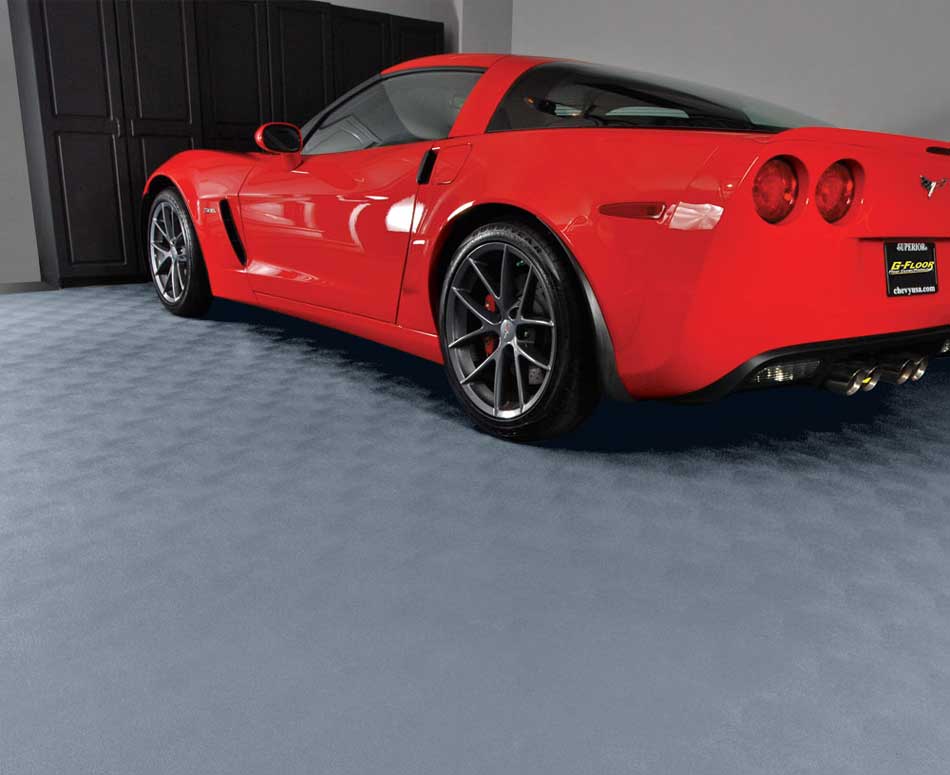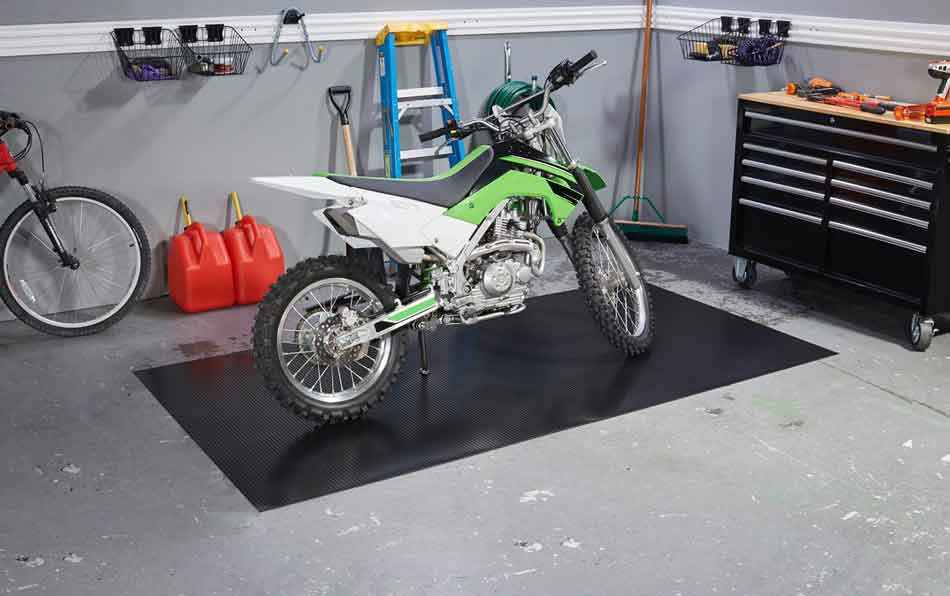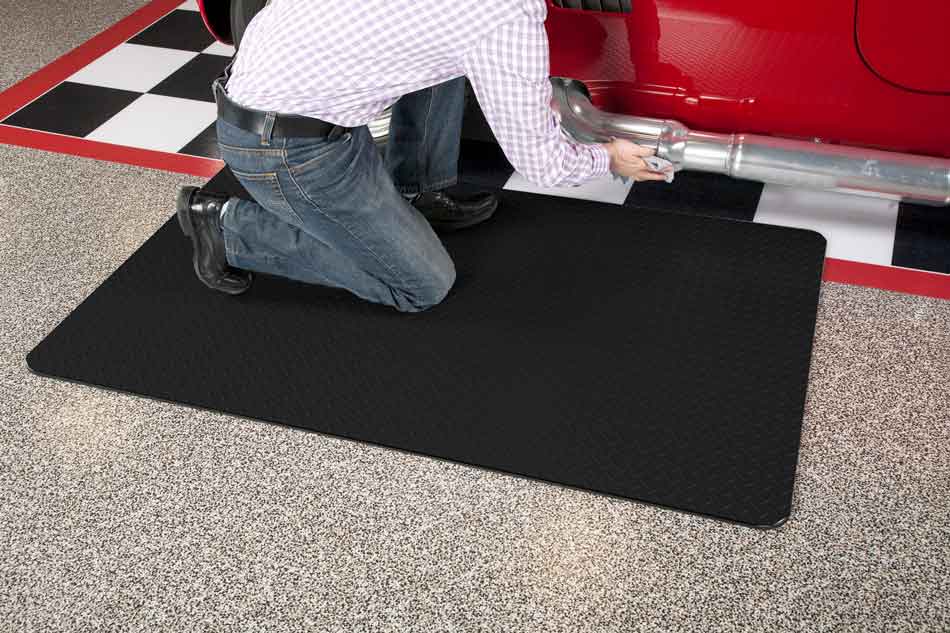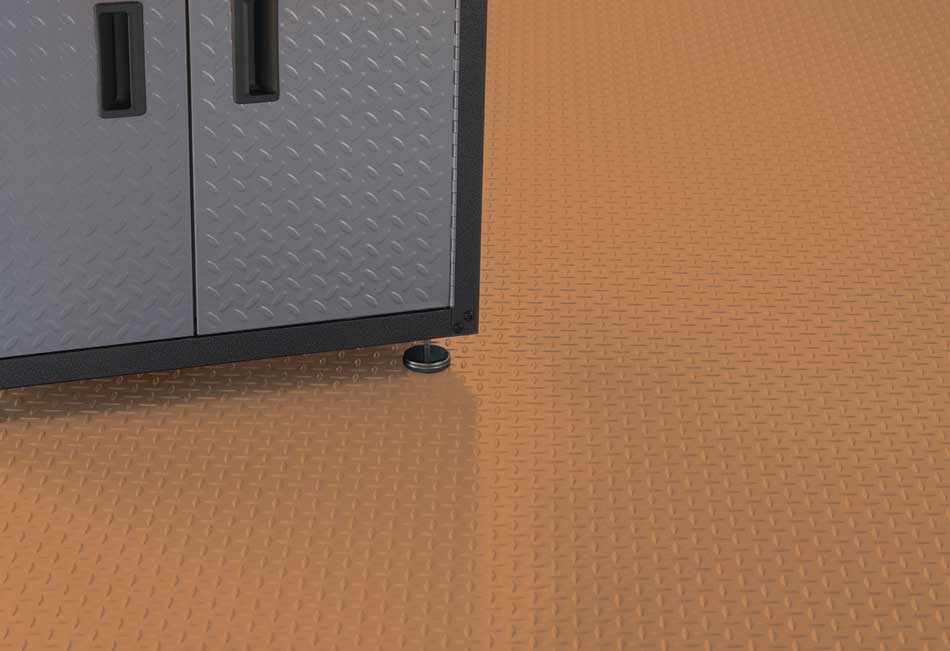Welcome to your definitive guide to the best garage floor mats for 2024!
Whether you’re a DIY enthusiast, a weekend mechanic, or someone who just wants to park their car without fuss, a well-chosen garage floor mat can significantly elevate your experience. We’re talking about more than just protecting your floor from stains and spills; the right mat can add safety, aesthetics, and even comfort to your garage.
In this article, we’ll break down the four types of garage floor mats and cover the pros and cons of different materials. Then, we’ll get into our recommendations for the best garage floor rolls, oil & maintenance mats, containment mats, and rubber floor tiles.
At the end of this article, you’ll know everything you need to make the best choice for your garage.
So, let’s roll up those sleeves and dive in!
TruContain HD Containment Mat |
G-Floor Vinyl Garage Flooring Mat (7’6″ x 17′) |
Drymate Oil Spill Maintenance Garage Floor Mat |
|
Primary Rating:
4.6
|
Primary Rating:
4.3
|
Primary Rating:
4.1
|
Types of Garage Floor Mats
Whether you’re looking to guard against spills, add a touch of style, or make your garage more comfortable, knowing your options can help you make the best decision.
We’ll cover garage roll-out mats, carpet mats, parking mats or pads, and water/ice/oil-absorbing mats. Then, we’ll explain what makes each type unique and suitable for specific needs.
Roll-out Mats
Garage roll-out mats are usually made from durable materials like vinyl, rubber, or polyvinyl.
These multi-purpose garage floor mats cover the entire floor and are incredibly resilient against chemicals, abrasions, and even UV rays. Plus, they’re great for reducing noise and providing some insulation.
However, they’re not perfect.
They may curl up at the edges or slide around, although adhesive tape can help. Also, these mats can expand or contract with temperature changes because they’re made from rubber or vinyl. They can be pricier than other options.
They’re available in standard widths like 7.5′, 8.5′, and 10′ and lengths up to 24′ or more, depending on the brand. Custom sizes are often available, too.

Carpet Mats
Carpet mats are typically crafted from polyester, nylon, or polypropylene.
They’re softer than other garage floor mats, making them comfy to walk or lie on. They bring a little style and warmth to your garage.
Watch out for spills, though. These mats can stain or hold onto odors if liquids are spilled on them.
They also offer minimal protection against dropping heavy objects and might require frequent cleaning to avoid dust mites or mold.
Carpet mats are usually sold in rolls or tiles, so you can cut them to fit any shape or size. Some standard dimensions are 2′ x 2′, 8′ x 30′, and 4′ x 6′.
Parking Mats or Pads
These mats are made of rubber, foam, or plastic. They’re perfect if you are only concerned about the area directly under your vehicle.
Parking mats are great at catching drips and spills and are easy to move or store when not in use.
On the downside, they only cover a limited area of your garage floor. They also tend to curl up at the corners, which could be a tripping hazard.
Parking mats come in various sizes to fit anything from motorcycles to SUVs. Common sizes include 3′ x 4′, 7.5′ x 17′, and 8′ x 22′.

Water/Ice/Oil Absorbing Mats
Absorbent mats are made from vinyl, PVC, polypropylene, or fabric. They are ideal if you live in wet climates or have an older car that’s prone to leaks.
Absorbent mats are designed to trap liquids and keep your floor dry, preventing slips and falls. However, since they don’t cover the entire garage floor, they typically wear out more quickly than other types of garage floor mats.
Also, they must be cleaned regularly to prevent odors or stains from setting in. These are designed to fit under one vehicle and come in sizes like 3′ x 5′, 6′ x 20′, and 7′ x 21′.
Garage Floor Mats & Rolls: Materials
After choosing what type of garage floor mat you need, you’ll want to give a little thought to how it’s made. Often, the type of material used in manufacturing can make a huge difference in how long the mat lasts or performs.
For example, a PVC-coated polyester fabric will be more durable and water-resistant than regular polyester.
Let’s get into some of the more common materials used.
Polyvinyl
Polyvinyl is made from synthetic, rubber-like materials and offers unmatched durability, water resistance, and stain resistance. They’re engineered to withstand chemicals, temperature fluctuations, and physical impacts.
However, be prepared to invest; superior quality often comes with a higher price tag. Unfortunately, it can be challenging to cut.

Styrene-Butadiene Rubber (SBR)
Styrene-butadiene rubber, or SBR, provides a noteworthy alternative to Polyvinyl. It’s wear-resistant, moisture-proof, and even offers anti-skid, anti-static properties with added traction and comfort.
SBR does have its limitations, though. It can emit a potent initial odor and is prone to discoloration over time. It’s also not the best for environments requiring heavy chemical or vehicle load resistance.
100% Polyester with Bonded, Waterproof Backing
If fabric is more your style, consider mats made of 100% polyester with bonded, waterproof backing. These highly absorbent mats resemble carpeting and are particularly effective for containing spills and debris.
They may not provide the best protection for your garage floor and could clash with the look of garage setups.
PVC Coated Polyester Fabric
PVC-coated polyester fabric is worth serious consideration for those in harsher climates or dealing with chemicals. They provide a robust layer of protection, making these mats water, chemical, and abrasion-resistant.
While undeniably durable, these mats can be bulky and cumbersome, which might not make them suitable for all garages or vehicles.
The material of your garage floor mat isn’t just another feature. It’s a pivotal factor that significantly influences its performance and lifespan.
The right choice here will pay off in durability, aesthetic appeal, and functional utility.
Choose wisely.
Best Garage Floor Mats
Choosing the right garage floor mat can be a game-changer – not just for the added protection but also to enhance the overall look and functionality of your space.
There are many manufacturers—each promising to be the ‘best’ in some way. It can be hard to sift through the noise to find the best for your garage.
That’s why we’ve done the legwork for you.
In this section, we’ll cut through the clutter to bring you a curated list of the best garage floor mats available.
Whether you’re looking for durability, ease of installation, or aesthetic appeal, we’ve got you covered.
Read on to find the perfect mat for your garage.
Best Garage Floor Roll: G-Floor Small-Coin Roll
While the rest of the garage floor mats in this list are designed to cover small areas, G-Floor vinyl garage flooring is a full-floor solution.
G-floor mats are considered the best garage floor rolls for the money. I decided to try it out to see if it’s worth the hype.
Key Features
- Material: 100% Polyvinyl
- Texture: Small coin texture for slip resistance.
- Ease of Maintenance: Easy to clean and maintain.
- Durability: Waterproof, resistant to scratches, cracks, and peels.
- Colors: Available in Midnight Black and Slate Grey
- Sizes: 5′ x 10′, 7′ x 6′, 8’6″ x 22′, 8’6″ x 24′, 10′ x 24′
- Origin: Made in the USA
The first thing that caught my eye was the quality and durability of the material.
The 100% polyvinyl construction is solid and thick, so you’re confident it’ll withstand abuse. After testing (okay…dropping stuff on it), I found it resistant to scratches and spills and easy to clean up.
I’ve read a few reviews that pointed out cracking, peeling, and staining issues. I haven’t had it long enough for it to crack, but I have noticed some minor staining, depending on what’s spilled on it.
I used the G-Floor small coin garage floor roll in my garage, and it made a massive improvement to the floor.
Some people may find the design too simplistic. The dark grey color and small coin texture are subtle but still make my garage look more upscale. It was reasonably comfortable to walk on but not as good as interlocking tiles from RaceDeck or Swisstrax.
Installation is relatively easy, but getting garage floor rolls aligned just right can be tricky. Adhesion is simple…but definitely get it right the first time. You need some patience with this step.
If you choose not to use adhesive tape, I can see how curling edges could be a problem. While I haven’t seen it with the G-Floor garage floor rolls, I’ve seen it happen with similar products.
Cutting the tile can be challenging. You’ll definitely need a heavy-duty boxcutter with a brand-new blade. Otherwise, you could end up with a sloppy cut that’ll ruin the look of your new garage floor.
The G-Floor small coin garage floor roll has a lot going for it: quality, durability, and great looks.
Overall, I think it’s worth every penny. If you’re looking for a great alternative to epoxy, this could be it.
- Midnight Black or Slate Grey
- 5' x 10', 7' x 6', 8'6" x 22', 8'6" x 24', 10' x 24'
- Made in USA
Best Oil Spill Mat: DryMate Maintenance Mat/Oil Spill Mat
If you have an older (or just leaky) car, you need something like the DryMate Maintenance Mat.
This is a premium maintenance mat that’s great at protecting your garage floor from oil, coolant, or gasoline spills while you’re working on your car. In my case, I have a car that’s notorious for leaky head gaskets. So this was the perfect way to protect my garage floor without spending a fortune.
It’s worth noting that many websites will recommend the Armor-All garage floor mat. DryMate makes both products, but their own branded product is slightly higher quality for a similar price.
Key Features
- Material: 100% polyester with bonded waterproof backing.
- Texture: Absorbent fabric designed to contain spills.
- Ease of Maintenance: Generally easy to clean, absorbs spills well.
- Durability: Good for routine use. Some reports of long-term issues like cracking and fading.
- Colors: Charcoal
- Sizes: 29” x 36”, 36″ x 59″
- Origin: Made in the USA
At first glance, the quality and durability of the DryMate Mat were generally high.
The absorbent fabric did an impressive job of containing small oil leaks and liquid spills. The waterproof/non-slip backing helped keep the mat in place, although I wouldn’t recommend turning your wheels on the mat.
The material is durable enough to withstand routine automotive work without any sign of wear and tear.
I’ve read reviews where people have noted issues with cracking, peeling, or fading. That raises questions about its long-term durability, but it wasn’t something I’d experienced.
There’s no “installing the DryMate Mat.” You drop it in place underneath your car, and you’re done.
That said, it’s worth buying a larder maintenance mat than you need, simply because it can be difficult to pinpoint your car’s leak unless you park in exactly the same spot every day.
Using a garage parking aid can help with that.
DryMate’s maintenance\oil-spill mat is functional, not aesthetic. But that doesn’t mean it’s ugly.
I liked that the mat looked like a low-pile carpet instead of a shop mat. It doesn’t detract from the look of my garage floor, and I can see it blending into certain floor colors.
Despite these advantages, there’s room for improvement.
Some people use the DryMate garage oil spill mat outside to protect their driveway from oil spills.
The mat isn’t weighted. Although the back of the mat has an anti-slip coating, a strong gust of wind will pick it up pretty quickly.
Overall, I really like the DryMate Maintenance Mat/Oil Spill Mat for what it is. It’s excellent at discreetly protecting your garage floors from spills. At this price, it’s a no-brainer.
Check out my full Drymate Oil Spill Mat review here.
- Absorbs and contains leaks and spills
- Protects garage floor surfaces
- Waterproof/Non-slip backing
- Easy to clean and reusable
- 29” x 36”, 36″ x 59″
- Made in the USA
Best Garage Containment Mat: TruContain HD
If you live up North where you get a lot of snow and sludge dripping off your car, you need the TruContain HD Containment Mat.
Key Features
- Material: Heavy-duty PVC
- Texture: Embossed texture makes it easier to clean.
- Maintenance: Generally easy to clean. May not hold water if the foam edges collapse.
- Durability: Durable but may face challenges in efficiently containing water and fluids.
- Colors: Gray
- Sizes: 8’6″ x 10′, 8’6″ x 18′, 8’6″ x 20′, 8’6″ x 22′
- Origin: Canada
The TruContain HD Garage Containment Mat was super-easy to install. Like other area garage floor mats, all you need to do is unwrap and unfold the mat, and it is ready to go.
It comes with free 3M Velcro corners and a squeegee head, which I found handy but unnecessary. It also includes foam corners that you slide into the mat to help prevent the water from spilling.
Because of its design, you won’t be able to cut the mat to fit, so be sure you purchase the correct size containment mat.
When I unboxed it initially, I was pleased with the durability and material of the mat. It felt heavy-duty and looked like it could withstand harsh weather conditions.
The challenge with garage containment mats is that they…well…contain the water off your car. That means there’s nowhere for the runoff to go, and it just has to evaporate.
That’s good in theory. But there were a few times when I accidentally stepped on the raised edge of the mat, allowing water to spill out onto the floor.
The mat’s gray color and embossed texture didn’t look too out of place in my garage.
This mat comes in four sizes to accommodate various sizes of vehicles. However, the only variation is the width. All mats are 8′ 6″ wide. Since I have a small SUV, that’s about three feet wider than my car.
That doesn’t sound like much until you have to step inside a mat that’s holding water. Your shoes had better be waterproof.
Depending on size, the TruContain HD Containment Mat is pricey. If you live in a less snowy area, opt for the original TruContain mat instead. There’s no arguing that this is a durable, heavy-duty mat. Still, it may be overkill for some regions of the country.
- 1.18″ edges to keep water from spilling on to your garage floor
- TruContain HD is a heavy-duty mat - 33% heavier than standard series TruContain mat
- 8'6" x 19', 8'6" x 20'. 8'6" x 22'
Best Rubber Tiles: Rubber Flooring Inc. 8mm Tiles
Rubber tiles are slightly different than the other options on this list. Rubber Flooring Inc.’s 8mm strong rubber tiles are a great option for special-use garages.
It’s an American-made product with features like recycled SBR rubber, easy installation, and a 15-year warranty.
Now that I’ve had time to install and test these tiles, I can share my thoughts on their performance, appearance, and overall value.
Key Features
- Material: Recycled styrene-butadiene rubber (SBR).
- Texture: Soft rubber with interlocking edges for easy installation.
- Maintenance: Easy to clean with a vacuum, damp cloth, or mild soap and water solution.
- Durability: Designed for heavy traffic and to resist movement.
- Colors: Available in 15 colors, ranging from solid black to speckled patterns.
- Sizes: 23″ x 23″ x 8 mm
- Origin: Made in the USA
One of the big selling points about tiles for me is how easy they are to install. These tiles come with interlocking edges designed to snap together without adhesives.
This allows you to change the layout or move them to another room if needed.
Cleaning is easy. All you need is a vacuum, a damp cloth, or a mild soap and water solution.
Rubber Flooring Inc.’s tiles are 8mm thick and weigh around 6.7 Lbs each, which sounds as heavy as it actually is. They’re sturdy enough to withstand heavy traffic and resist movement.
Whether you’re placing heavy gym equipment or just walking over them, these tiles won’t slide or shift.
These tiles come in 15 colors, from solid black to speckled patterns.
Overall, these 8mm rubber tiles by Rubber Flooring Inc. offer good quality, durability, and ease of use. Their aesthetic appeal and versatility make them a viable choice for various indoor settings. This could be a worthwhile investment if you’re looking for a generally reliable and easy-to-install flooring option.
- Easy do-it-yourself installation.
- Seamless appearance.
- 5-year warranty.
- Made in USA
FAQs
Why should you install a floor mat in your garage?
There are plenty of advantages to getting a floor mat for your garage. But they can all be summed up in three points:
- Rain, snow, mud, oil and automobile fluids will inevitably drip off your car and a good garage floor mat will help you keep your garage clean.
- A good garage floor mat will also serve to protect your garage floor by keeping it dry.
- Garage floor mats are much more comfortable when you have to get down on your knees or lie down and work on your car.
Can I use a floor mat with a garage drain?
This depends on your garage. If you have a floor drain in your garage, you could cut an opening in the mat to allow liquid to drain out. If you don’t use the drain, then there’s no harm in covering it up with the floor mat.

How do I clean my garage floor mats?
In most cases, you should be able to brush the dirt away with a broom or wipe it off with some rags. If you do this regularly, it is highly unlikely that there’ll be any serious stains that require immaculate cleaning.
For tougher stains, you can use a general household cleaner or apple cider vinegar (yes, really). You can also use diluted Pine-Sol or other cleaners. For extremely difficult stains, you can use very diluted bleach, but beware that it may also take some of the color of the floor as well.
Wrapping It Up
As we end our deep dive into the best garage floor mats for 2024, we’ve covered a lot of ground. Whether your garage is a high-performance workshop or a simple parking space, the right mat can make all the difference.
- G-Floor Small Coin Garage Flooring: Designed for durability and aesthetic appeal, G-Floor Small Coin Garage Flooring is an excellent choice for those looking to upgrade their garage space. The product features a unique small coin texture that enhances its look and provides added traction, reducing the risk of slips and falls. Easy to install and clean, this flooring is made from 100% high-quality polyvinyl, making it resistant to common garage chemicals, oils, and moisture.
- DryMate Maintenance Mat/Oil Spill Mat: Aimed at keeping your workspace clean and safe, the DryMate Maintenance Mat/Oil Spill Mat is perfect for capturing leaks, drips, and spills. Made from an absorbent, waterproof material, this mat is ideal for garages, cars, or any area where you might handle liquids. Its lightweight design makes it easily portable and can be cut to fit any space.
- TruContain HD Containment Mat: Designed for heavy-duty use, the TruContain HD Containment Mat is a robust solution for containing spills and debris in your garage. Made from thick PVC fabric, this mat can withstand the weight of heavy vehicles and equipment. Its raised edges create a containment field that prevents liquids and dirt from spreading, making clean-up a breeze.
- Rubber Flooring Inc: 8mm Rubber Tiles: Offering a mix of durability, ease of use, and versatility, these 8mm rubber tiles are ideal for various applications, from home gyms to garages. The interlocking design makes installation quick and straightforward. At the same time, the recycled SBR rubber material offers a sustainable and durable flooring solution. Available in 15 colors and patterns, these tiles can match most design schemes. However, there have been some reports of color inconsistencies.
Each of these products serves a specific need and has advantages and disadvantages.
Depending on your requirements, one of these could be the best garage floor mats for your home.
TruContain HD Containment Mat |
G-Floor Vinyl Garage Flooring Mat (7’6″ x 17′) |
Drymate Oil Spill Maintenance Garage Floor Mat |
|
Primary Rating:
4.6
|
Primary Rating:
4.3
|
Primary Rating:
4.1
|







